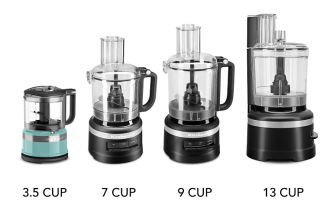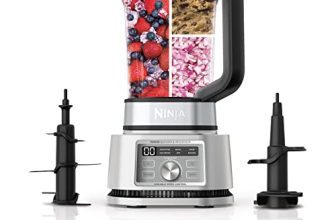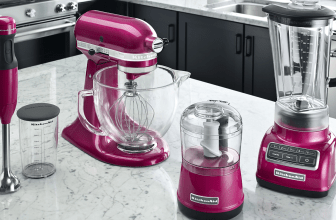As an Amazon Associate I earn from qualifying purchases.
What Can You Use In Place Of A Food Processor?
What Can You Use In Place Of A Food Processor? When necessity calls, sometimes it’s the lack of advanced kitchen gadgets that sparks creativity. The absence of a food processor, for example, doesn’t have to stall your culinary ambitions. In such situations, traditional tools like knives and graters can be surprisingly effective in achieving similar results.
Historically, chefs have relied on these manual tools long before the advent of modern food processors. An expert might grab a simple mortar and pestle to grind spices or blend ingredients, maintaining control over texture. According to a culinary study, professional chefs often still use these methods for their superior precision and nuanced control.

What can you use in place of a food processor?
In the kitchen, improvisation can save the day. When you don’t have a food processor, a knife can be your best friend. Sharp and versatile, a knife can chop, slice, and dice with precision. For softer ingredients, a vegetable peeler can also help create thin strips. These basic tools cover many tasks typically handled by a food processor.
A mortar and pestle is another excellent substitute. These ancient tools are perfect for grinding spices, making pesto, or crushing garlic. Using them allows for more control over texture and flavor. It might take more time, but the result is often worth it. Plus, there’s something satisfying about using such traditional methods.
Blenders can also step in when a food processor is unavailable. While not ideal for kneading dough or slicing vegetables, they excel at mixing liquids and pureeing foods. With the right settings, a blender can handle smoothies, soups, and even some batters. Just be sure to work in small batches for the best outcome.
In some cases, even a simple grater can be useful. Graters are handy for shredding cheese, vegetables, and even fruits. They are easy to clean and store, making them practical alternatives. To make things easier, here are some common kitchen tools you can use:
- Knife
- Mortar and pestle
- Blender
- Grater
Using a Knife instead of a food processor
A sharp knife is a must-have tool in the kitchen. When you don’t have a food processor, a well-maintained knife can take its place for many tasks. Slicing vegetables, chopping herbs, and dicing onions are just a few examples. With practice, you can achieve precise cuts that rival a machine. Plus, using a knife gives you full control over the size and shape of your ingredients.
Knives also add a personal touch to your food prep. When mincing garlic or chopping nuts, you can adjust the pressure and speed to get the texture just right. This flexibility is something a food processor can’t offer. You can also easily switch between different types of cuts. Whether you want thin slices or chunky pieces, a knife can do it all.
To keep your knife working at its best, regular maintenance is key. Sharpening your knife and honing it often will make your cutting tasks easier. Storing it properly also extends its life. Here are some tips for maintaining your knife:
- Sharpen the blade regularly.
- Use a honing steel to keep the edge aligned.
- Store in a knife block or magnetic strip.
- Hand wash and dry immediately after use.
Moreover, understanding different knife techniques can enhance your cooking experience. For example, the rocking motion used in chopping helps you work efficiently and safely. The claw grip keeps your fingers safe while cutting. Investing time in learning these skills will make substituting a knife for a food processor much easier. Plus, it turns meal prep into a more engaging and satisfying process.
Using a Mortar and Pestle in place of a food processor
A mortar and pestle is a timeless tool found in kitchens worldwide. It’s perfect for grinding spices, which enhances their flavors more than a food processor can. Crushing garlic or ginger in a mortar and pestle releases essential oils, intensifying the taste. This manual method also provides better control over the texture. Whether you want a coarse or fine grind, it’s all in your hands.
Making pesto in a mortar and pestle can be a rewarding experience. Unlike a food processor, it allows you to control the pace and consistency, giving you a more rustic result. The result is often richer in flavor and texture. You can easily adjust the amount of olive oil, nuts, and cheese for a personalized touch. These elements come together harmoniously in this traditional method.
Maintaining your mortar and pestle is straightforward. Simply wash it with warm water after each use to keep it clean and ready for the next task. Avoid using soap as it can absorb into the porous surface. Let it air dry completely before storing. This ensures it lasts a long time and stays in good condition.
A mortar and pestle can also be used for making pastes and marinades. Combining fresh herbs, spices, and liquids in the mortar and pestle brings out their best qualities. The act of crushing helps blend the ingredients more thoroughly. Here are some common uses:
- Grinding spices
- Making pesto
- Crushing garlic or ginger
- Mixing pastes and marinades
Implementing a Blender rather than a food processor
A blender can be a suitable substitute for a food processor in many scenarios. Perfect for liquid-based tasks, blenders excel at making smoothies, soups, and sauces. They break down fruits and vegetables quickly, turning them into fine purees. While you may not achieve the same texture as a food processor, the results are often impressive. Just ensure to use enough liquid to keep the blades running smoothly.
Blenders also shine in making dips and spreads. Whether it’s hummus, guacamole, or salsa, a blender can blend ingredients smoothly and efficiently. Pulse settings allow for better control over the texture. Adding ingredients gradually helps in achieving the desired consistency. These features make blenders versatile kitchen tools.
Maintaining a blender is straightforward and ensures its effectiveness. Regularly clean the blades and jar to avoid build-up of food particles. For stubborn stains or smells, blending a mix of water, baking soda, and lemon can help. Proper maintenance extends the life of your appliance. Here’s a quick cleaning tip list:
- Rinse immediately after use
- Use soap and warm water
- Blend a baking soda and lemon mix for deep cleaning
- Dry components thoroughly before storing
However, a blender isn’t perfect for all tasks. It’s less effective at kneading dough or shredding firm vegetables. For tasks requiring precise cutting or grating, traditional tools like knives or a grater are better suited. Still, a blender remains a valuable ally in the kitchen, capable of handling a variety of culinary tasks.
The Advantages of Manual Tools Over Food Processors
Manual tools offer a lot of control over the cooking process. With a knife, you can choose the exact size and shape of your cuts. This kind of precision is hard to achieve with a food processor. Moreover, using manual tools promotes mindful cooking. Every chop and slice is a deliberate action, making the overall experience more engaging.
Another advantage of manual tools is their simplicity. They don’t require electricity, making them perfect for outdoor cooking or in kitchens with limited outlets. Knives, graters, and peelers are easy to clean and maintain. They don’t have complicated parts that need regular servicing. This makes them a practical choice for day-to-day kitchen activities.
Manual tools are also more versatile. For example, a single knife can perform multiple tasks like slicing, dicing, and chopping. A grater can handle cheese, vegetables, and even zest citrus fruits. This multifunctionality reduces the need for multiple appliances, saving space in your kitchen. Here are some multifunctional manual tools:
- Knives
- Graters
- Peelers
- Mortar and pestle
Lastly, manual tools are often cheaper than food processors. They are budget-friendly options for those who are just starting to stock their kitchen. Even high-quality knives and graters come at a fraction of the cost of a food processor. This makes manual tools accessible to everyone, no matter their budget.
Manual kitchen tools also have a smaller environmental footprint. They don’t consume electricity and usually last longer than their electric counterparts. This durability makes them a more sustainable choice over time. Investing in good-quality manual tools can pay off in more ways than one.
Enable Versatility with Tools other than Food Processors
Manual kitchen tools bring a diverse range of uses, making them exceptional alternatives to food processors. A knife, for instance, can be used for chopping, slicing, and dicing a variety of foods. Its versatility allows you to prepare ingredients for many different recipes. This one tool can handle anything from mincing garlic to carving a roast. Additionally, the knife’s adaptability ensures your cooking remains both efficient and precise.
Graters and peelers are other versatile tools that shine in multifunctionality. Graters can be used for shredding cheese, zesting citrus, or even grating vegetables for salads. Peelers work similarly but focus more on peeling vegetables and fruits. Both tools save time and add a layer of convenience. Plus, they’re lightweight and easy to store. This makes them a practical addition to any kitchen setup.
Mortar and pestle sets offer versatility as well. These tools are great for grinding spices, making pastes, and even crushing nuts. They give you complete control over the texture of your ingredients. Here’s what you can do with a mortar and pestle:
- Grind spices like peppercorns and cumin
- Make flavorful pesto and guacamole
- Crush nuts for desserts and sauces
Blenders can also provide versatility in the kitchen. While not ideal for chopping, they are excellent for making purees, soups, and smoothies. With adjustable speed settings, blenders can achieve different textures, making them highly adaptable. This functionality allows blenders to handle a variety of liquid-based recipes with ease. It’s another reason why having a blender is essential in any kitchen.
Even items like rolling pins and mallets have surprising uses. A rolling pin can flatten dough and crush crackers or cookies. A mallet can tenderize meat but also crush ice. These tools extend beyond their primary functions, making them valuable assets in meal preparation. Therefore, relying on various manual tools can offer a well-rounded culinary experience.
How Chefs Substitute Food Processors
Professional chefs often rely on manual tools when a food processor isn’t available. Knives are their go-to for precision and control. With skillful technique, they can achieve perfect slices and fine dices that elevate any dish. Chefs appreciate that knives allow for meticulous detail. This attention to detail can make a significant difference in the final presentation.
Mortar and pestle sets are staples in many restaurant kitchens. Chefs use them to grind spices, prepare pesto, and create flavorful sauces. The manual grinding motion releases essential oils from herbs, enhancing their aroma and taste. This method is more hands-on but yields deeply flavorful results. It’s this kind of authenticity that chefs strive for in their culinary creations.
Blenders serve as another useful tool for professional kitchens. They excel at pureeing fruits and vegetables for soups, smoothies, or sauces. By adjusting speed settings, chefs can achieve a range of textures, from smooth to chunky. Blenders also simplify tasks like emulsifying dressings or blending batters quickly. Their versatility makes them indispensable in busy restaurant environments.
For some specific tasks, chefs prefer using graters over food processors. Grating cheese by hand ensures uniform shreds that melt evenly across dishes. Fruits and vegetables can also be grated to add texture to salads or garnishes to entrées. The tactile feedback helps chefs monitor the consistency better than machines can offer. Below are common uses of graters in professional kitchens:
- Shredding cheese
- Zesting citrus fruits
- Grating root vegetables like carrots or ginger
Additionally, rolling pins come into play more often than one might expect. Chefs use them not just for dough but to crush items like cookies or nuts for various recipes. Mallets are employed to tenderize meat effectively while doubling up as ice crushers during busy service times. These versatile tools streamline kitchen operations without compromising on quality.
Improvised Tools in a No-Food-Processor Scenario
When a food processor is unavailable, improvisation can fill the gap effectively. A meat mallet is perfect for tenderizing meats but can also crush cookies or nuts. It’s a versatile tool that turns unwieldy chunks into manageable pieces. You can also use it to flatten chicken breasts or pork chops. This multi-functionality makes it handy in the kitchen.
Rolling pins are another great resource when you’re without a food processor. Besides flattening dough, a rolling pin can crush items like crackers or graham crumbs. Wrap the items in a cloth or plastic bag, and roll over them until they are finely crushed. This method works well for pie crusts or breading. Plus, it’s a great way to relieve some stress.
Another useful tool is a fork, especially for mashing soft foods. Forks can effectively mash potatoes, avocados, or beans into a smooth paste. This is very practical for quick tasks. It’s also easier to control the texture, making it as fine or chunky as you like. Here are some common uses for a fork:
- Mashing avocados for guacamole
- Flattening potatoes for mashed potatoes
- Mixing ingredients for simple salads
A whisk can double as a stand-in for a food processor in certain tasks. It’s excellent for mixing batters, sauces, and even scrambled eggs. The rapid motion of a whisk helps to blend ingredients evenly. While it might take more elbow grease, the end result is usually worth it. Plus, using a whisk can be a real workout!
Glass jars can serve a surprising purpose, too. They are excellent for muddling herbs or crushing peppercorns. You can also use the bottom of a jar to smash garlic cloves. This gives you more control over the crushing process. From jars to mallets, creative improvisation can keep your cooking routine on track without a food processor.
Frequently Asked Questions
If you ever find yourself without a food processor, there are many alternatives. Here, we answer some common questions about using different kitchen tools in place of a food processor.
1. Can I use a blender to chop vegetables?
Yes, you can use a blender to chop vegetables, but with some adjustments. Pulse the blender instead of running it continuously to avoid over-processing. Also, cut the vegetables into smaller pieces before blending. This ensures even chopping without turning the veggies into puree.
It’s advisable to work in small batches for better control. Using too many vegetables at once can result in inconsistent chopping. A blender is helpful for softer vegetables like tomatoes but may struggle with harder ones like carrots.
2. How do I make nut butter without a food processor?
You can make nut butter using a high-speed blender or an electric hand mixer. First, roast your nuts until fragrant to bring out their oils and flavors. Let them cool slightly before adding to your blender or mixer with some oil (like almond or peanut oil).
Blend on high speed until smooth, stopping occasionally to scrape down the sides of the container. If you’re using an electric hand mixer, use a deep bowl and mix on medium-high speed for best results. Be patient; this process takes time.
3. Is using a mortar and pestle effective for grinding spices?
Yes, a mortar and pestle is excellent for grinding spices. It allows you to control the coarseness of the grind better than electric grinders do. Manual grinding releases essential oils from spices, enhancing flavor and aroma significantly.
This traditional method also provides tactile feedback, helping you achieve just the right consistency for your recipes. While it requires more time and effort compared to an automatic grinder, many chefs believe it’s worth it for the superior taste.
4. What are other manual tools for kneading dough if I don’t have a food processor?
If you don’t have a food processor, kneading dough by hand is a good option that has been used traditionally for centuries. All you need is a clean countertop or large mixing bowl and your hands.
An alternative is using a stand mixer with dough hooks which mimic hand-kneading motions very effectively. Despite requiring elbow grease when done manually, these methods offer exceptional control over dough consistency without high-tech appliances.
5. Are there any drawbacks to substituting manual tools for electrical ones?
The main drawback of using manual tools instead of electrical options like food processors includes increased physical effort and time consumption since manual tasks tend not only slower but often physically demanding as well increasingly progressively amongst amateurs above-all-time-saving techniques utilized through contemporary tech advancements sorted daily-moreons outputalbeit!
Conclusion
Substituting a food processor with manual tools can be surprisingly effective. With the right tools and a bit of practice, you can achieve precise results that maintain the quality of your ingredients. This approach also adds a personal touch to your cooking, making the process more engaging and fulfilling.
Moreover, manual tools offer versatility and sustainability that electric gadgets can’t match. They require no electricity and often last longer, making them a wise investment for any kitchen. Whether you’re a professional chef or a home cook, these tools provide reliable alternatives when a food processor is not an option.






